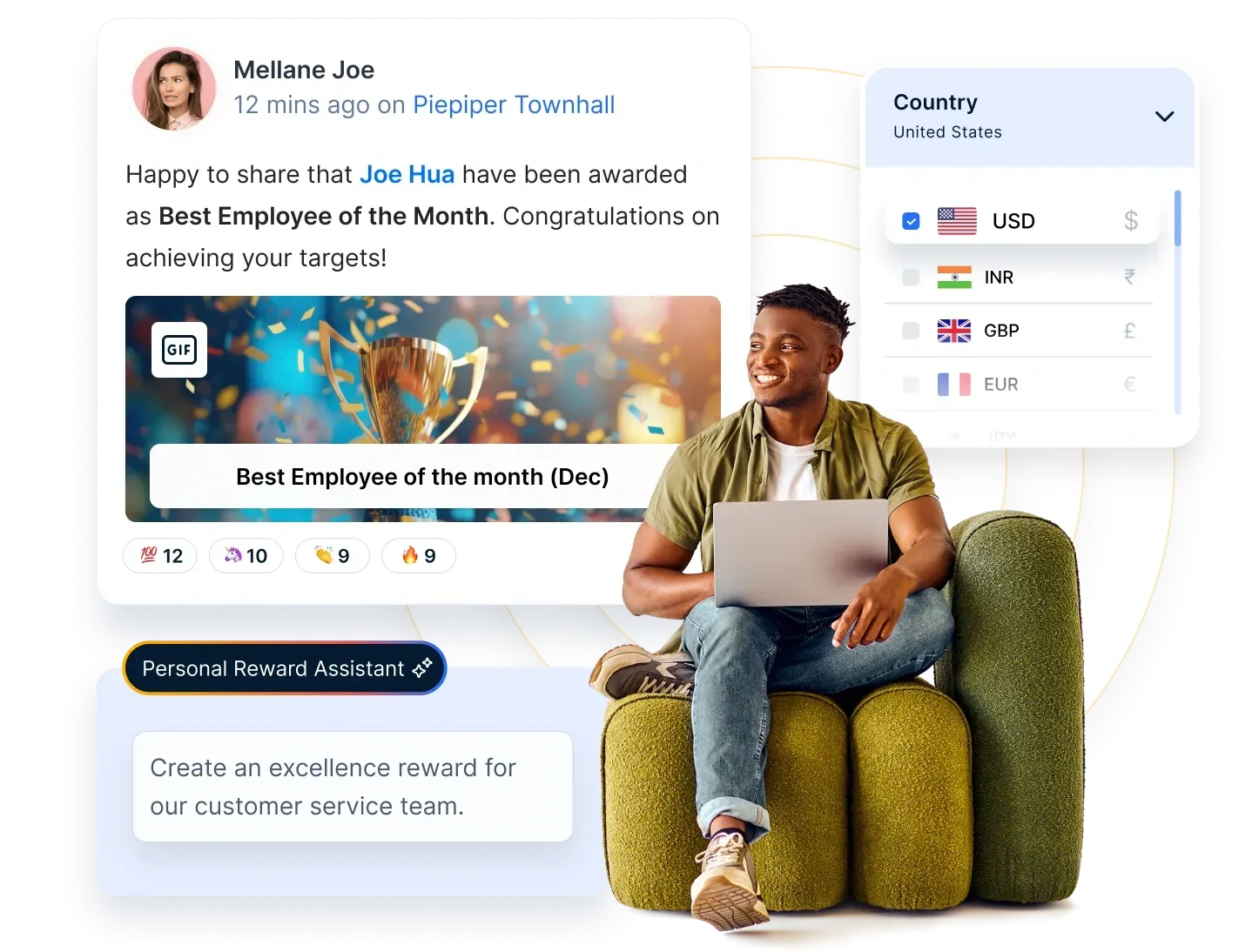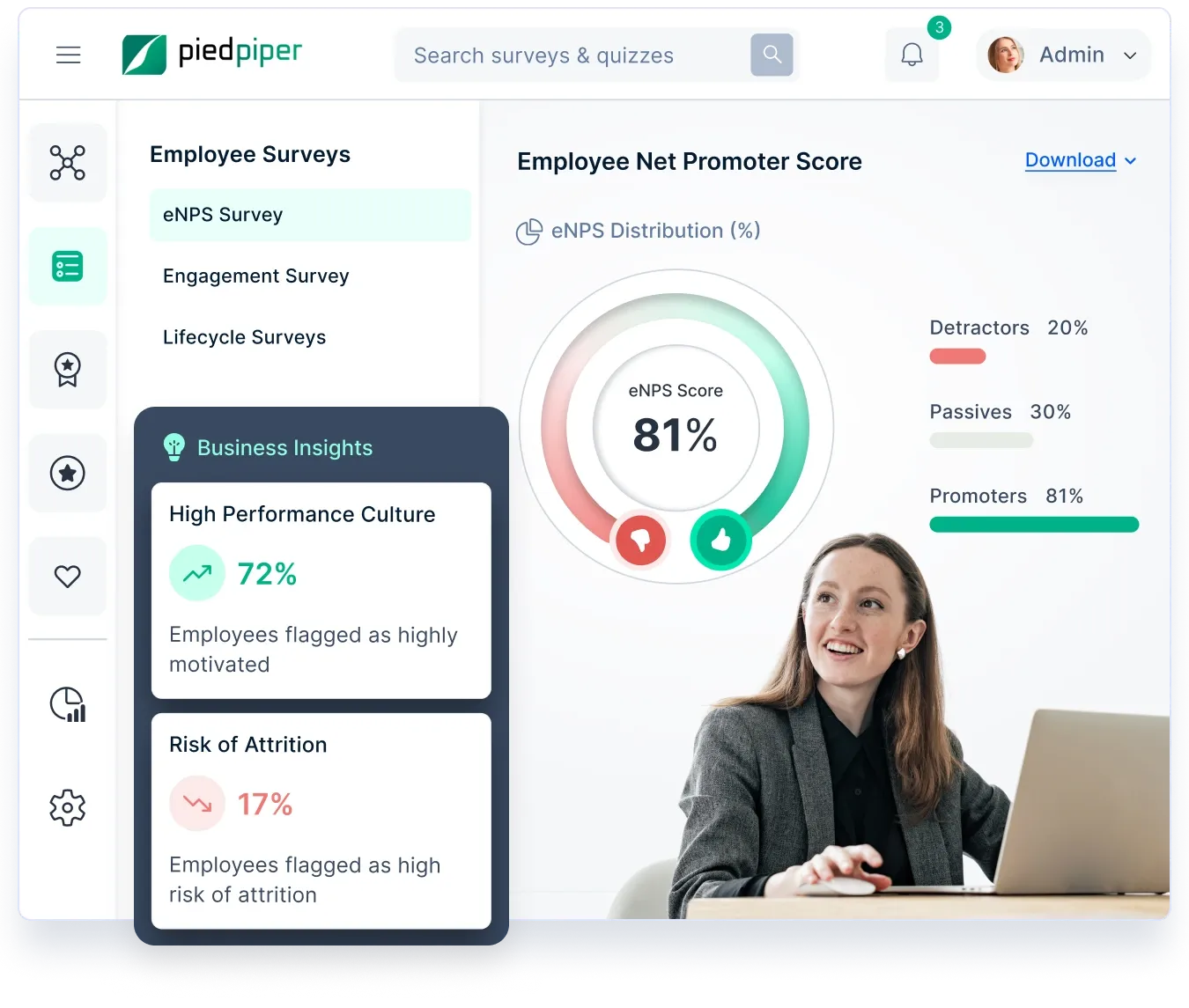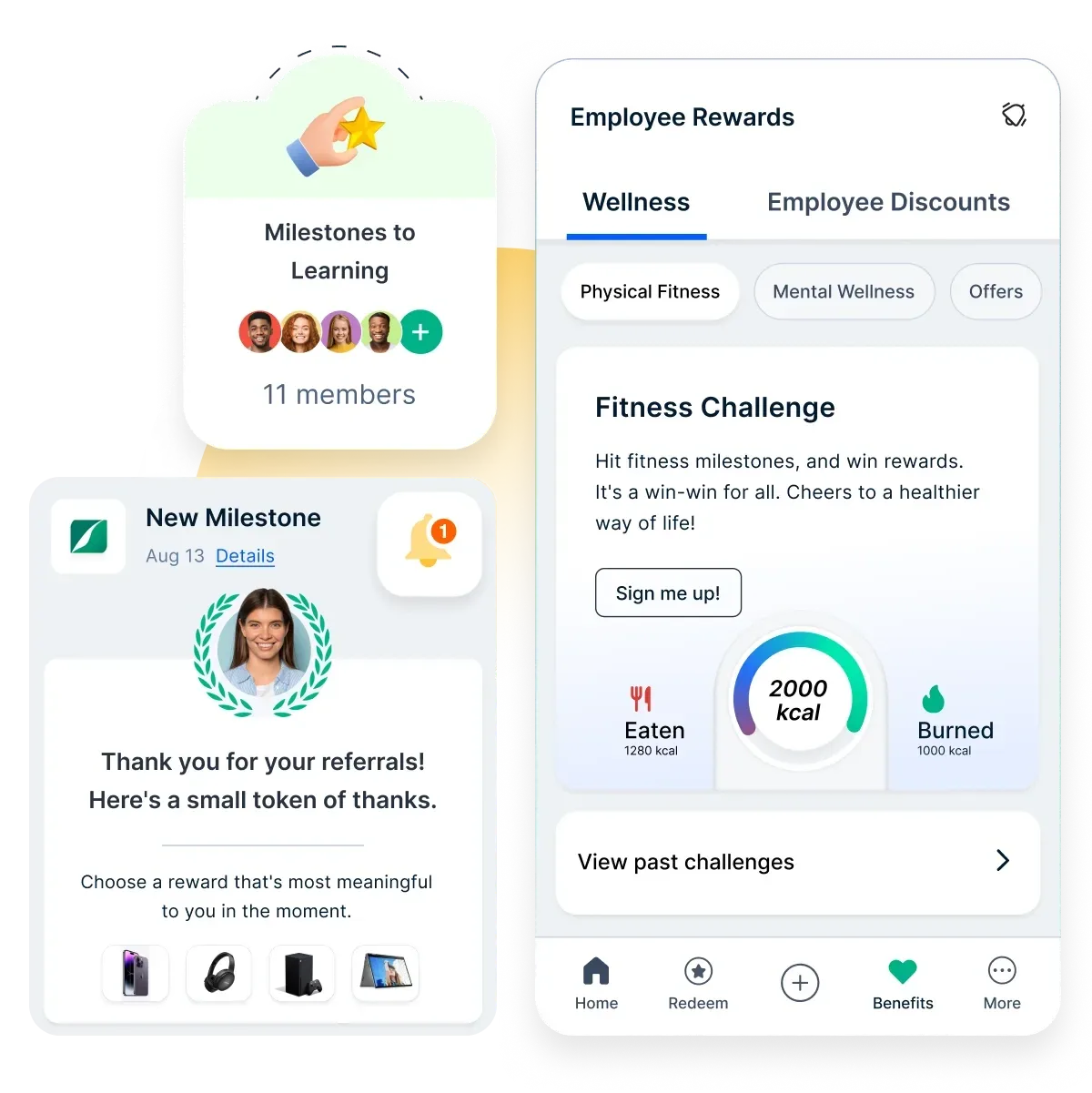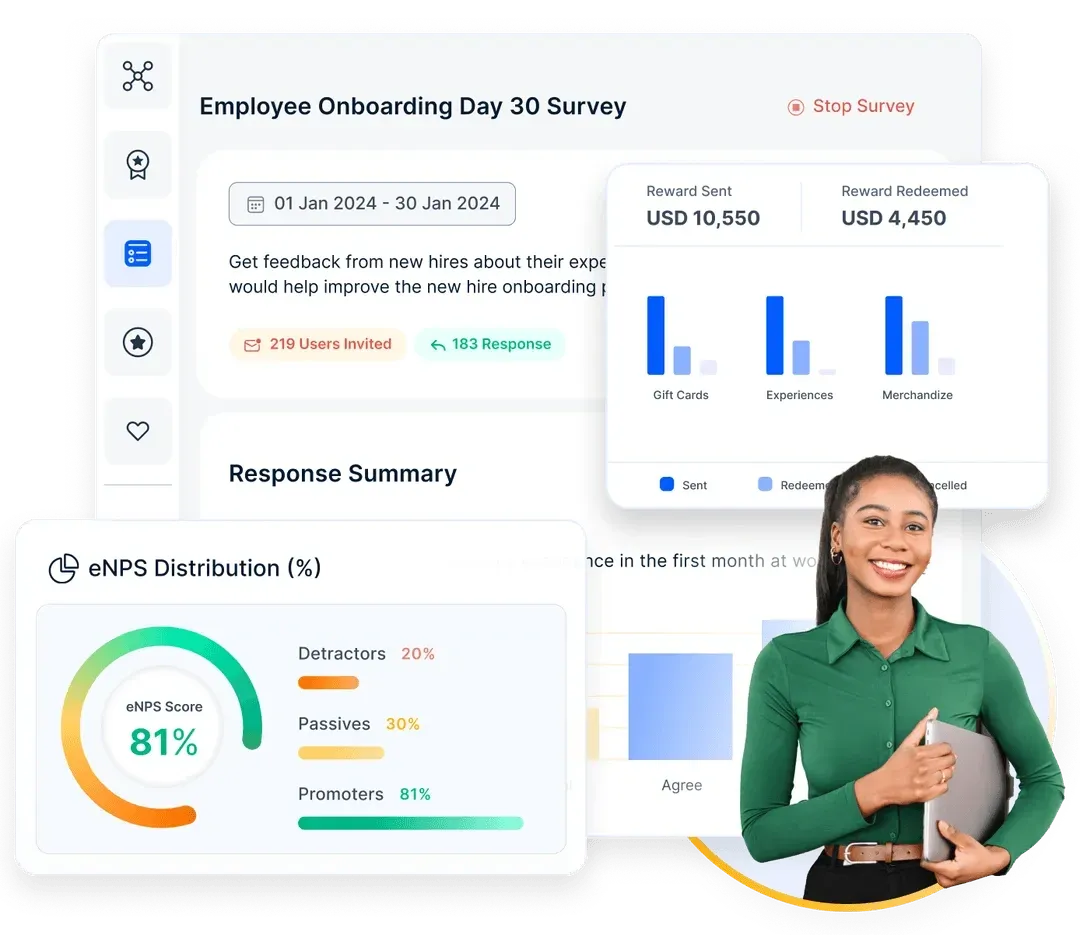On this page
- But what does organizational vision mean?
- You’ve started with the why: Now start sharing the organizational vision
- Purpose, good. Shared purpose, great.
- More than pop psychology: It’s science.
- Why command and control, when you can collaborate and co-engineer?
- Advantages of sharing the Oar
- Examples of employee engagement being boosted by a shared vision
- How to engage employees by sharing organizational vision with them?
- How Empuls helps organizations sustain and share their vision
To truly engage people at work, you must SHARE your organizational vision with them.
"Few, if any, forces in human affairs are as powerful as shared vision." - Peter M Senge, Author of 'The fifth discipline: the art and practice of the learning organization.'
When Dunkin Donuts stated, "We make delicious coffee in well-merchandised stores," in their purpose statement, customers took note. However, when Coke described its mission as "To refresh the world" however," we stopped, smiled, and reached out for a bottle.
What Coke did was add the WE to the ME. It didn't say it manufactures cola drinks (which is, of course, what it primarily does). It insisted that it wanted you and me to be invigorated with every experience. And the thought connected instantly because that's exactly what you and I want at the end of the day: A sip that makes the fatigue disappear.
The above may be a brand-consumer dynamic, but it plays out with the same enthusiasm when the two parties in the equation are (A) company and (B) employees.
But what does organizational vision mean?
An organizational vision is a clear and inspiring statement that defines what an organization ultimately wants to achieve or become in the future. It reflects the long-term aspirations and purpose of the company, serving as a guiding light for decision-making, strategy, and culture.
A strong vision aligns employees toward a common goal, motivates them to contribute meaningfully, and helps leadership steer the organization through change and uncertainty. It’s not just a statement on a wall—it’s a shared belief that fuels collective action.
You’ve started with the why: Now start sharing the organizational vision
Organizational vision needs to ultimately lead to engaged employees. What is Employee Engagement? Well, the term has been variously defined. Employee engagement can be explained as the level of attachment an employee feels towards an organization and its goals.
Note that it is not always the same as employee satisfaction or employee happiness, though these can be important indicators. Making time to make sure your employees are engaged isn’t just ‘good HR’, it’s good business.
According to Towers Perrin's research, companies that boasted an engaged workforce pocketed 6% higher profits. A research by Kenexa, businesses with an engaged workforce fetch 5X stakeholder returns over a 5 year period.
We have discussed the importance of starting with the purpose to engage workers in an earlier article. As it turns out though, having a powerful WHY is only the first step.
For you to have a workforce that’s genuinely engaged, motivated, and fulfilled, your organizational WHY must align closely with your workers’ WHY: The reason that makes each of your team members get up in the morning and head to work.
A disengaged employee is highly likely to interpret work as ‘boring’ and underperform, whereas an engaged employee with a shared and aligned vision produces positive augmented results.
Several studies were conducted where employee groups were tasked with a job that would result in a reward. At some point during the experiment, performance dropped dramatically even when the incentive level was cranked up.
While flummoxing at first glance, the rationale triggering the behavior was profoundly simple. Every time a task, assigned randomly, turns out to be ‘boring’. With zero motivation for the job, efficiency plummeted.
Purpose, good. Shared purpose, great.
A Mercer | Sirota research indicates that ‘achieving something meaningful’ is one of the main pillars of employee engagement. The underlying reason for this observation was not just noble for the organization but also selfish for the employees. Nobody wants to be spending their life striving for something meaningless to themselves.
The innate desire to ‘co-create’ a meaningful project - is important for human beings. If leaders sense a lack of drive in their employees, it is a message for them to review their own approach and adjust their sails.
For instance, even the iconic US President George Washington actively sought the support of his peers and countrymen for his bold plans. Entertainment magnate Walt Disney built an empire by accommodating feedback graciously. Closer to modern times, communicating (with both internal and external stakeholders) clearly and frequently is one of the pillars of Jeff Bezos’ leadership style.
“Certainly a leader needs a clear vision of the organization and where it is going, but a vision is of little value unless it is shared in a way, so as to generate enthusiasm and commitment. Leadership and communication (of purpose) are inseparable.”- Claude Taylor
More than pop psychology: It’s science.
Purpose has sturdy behavioral science underneath. Sharing a vision leads to the creation of synergy - a powerful tool to not just make things work, but to do so by consuming less time, energy, and resources (without sacrificing quality or quantity of output). It is deep coded to dissolve differences, join invisible dots and ‘figure out’ common routes of forwarding motion.
“Synergy is better than my way or your way. It’s our way.”- Stephan Covey
An ecosystem that is synergistic at heart is able to absorb the turmoil of transition and breed new competencies into the system to make it more resilient and responsive. It doesn’t just convert current prospects but opens new doors of opportunity.
Why command and control, when you can collaborate and co-engineer?
A stark ‘collaborate and co-engineer was demonstrated by Marc Benioff, CEO of Salesforce.com. He threw his leadership team session ‘virtually open’ for all employees to attend it from anywhere they want. On that day, he didn’t just share a screen, he shared a future.
Purpose beats the playbook, almost every single time.
General Stanley McChrystal, in his book Team of Teams, argues that teams adapt more easily and respond with greater agility when harmonized by a common passion. This can be a priceless trait to have in times of rapid, technology-driven change. A shared journey acts as a compass, focussing all ideas and energies towards achieving the end in the smartest possible way.
“The speed and independence of our current environment means that what we can not know has grown even faster than what we can.” - Stanley McChrystal, Team of Teams
When you don’t have a manual or precedence to fall back on, a heuristic is your only resort for real-time decision-making. When you are not sure about the ‘right’ step to take, a common aspiration makes things easy. All you have to ask is, “Will this be good for the team?”
Advantages of sharing the Oar
Sharing a vision brings more benefits for the team than cohesion. When employees are truly engaged – that is, motivated in their role and take pride in their job - they become self-driven and make valuable contributions to the organizational journey.
They will instinctively skill up in optimal ways, align abilities with targets, brainstorm for best ways forward, improvise to remove bottlenecks and operate with minimal supervision to ensure KPIs are met. Below given are the list of advantages of shared purpose:
- Close-knit, motivated, positive, and result-driven ecosystem.
- Self-aligned, self-appraising, self-correcting teams.
- Big savings on training and orientation costs (self-improvement).
- Quicker strategy implementation due to goal alignment.
- Robust and dynamic knowledge base (continuously shared learnings).
- Naturally innovative culture.
- Organic decision-making.
- Boosted performance via enhanced efficiency.
- Stable teams with low attrition.
- Better employee work-life balance
Examples of employee engagement being boosted by a shared vision
Let’s decode a few examples of the greater good.
1. Manhattan project
The fervor was palpable during the Manhattan Project when a group of specialists scattered around the atlas managed to maintain complete secrecy as they carried out their highly covert nuclear program (aimed to stall the relentless progress of the Germans) during WWII. Despite being separated from each other by miles, the steely, shared resolve to stave off a common enemy acted as a powerful glue, ensuring success for the collective project.
2. Wright brothers
The energy was electric when the Wright Brothers (and their rag-tag team) toiled endlessly to ultimately build a machine that could ‘fly’. Their ‘rival’ Samuel Pierpont Langley - the prominent social influencer of the time - failed in his mission to build the world’s first airplane despite being flush with resources. The difference? Langley was going for fame and money, while each member on the Wright team was fired by an entirely different motivation: They wanted to change the course of history.
“If we all worked on the assumption that what is accepted as true is really true, there would be little hope of advance.”- Orville Wright
The way the Marvel Universe has seamlessly expanded its narrative galaxy, and the way Wikipedia has evolved into a mammoth, interactive knowledge bank are other examples of this synergy. These are all goosebump-raising reminders of the kind of wonders that are possible when conviction and will run through the veins of many, instead of just one.
How to engage employees by sharing organizational vision with them?
One way forward for leaders is to explain their vision honestly and clearly with the rank and file to inspire people. Awareness (or the lack of it) lies behind more problems of the world than we realize.
It is perfectly possible that better familiarization with the necessity, urgency, and impact (both short and long term) behind a certain organizational goal generates enthusiasm and support for an idea that was initially greeted with indifference. You must translate your vision into words that connect. Unfortunately, data tells us that effective communication is an area where most leaders struggle.
In a Weisman Success Resource study 70% of leaders attribute their team’s performance achievements as well as issues to their own communication effectiveness
Here are the other steps that can ensure your shared roadmap hits the tarmac with minimum fuss:
1. Unify your clan
Shared vision may start scattered. Someone has to take the responsibility to bring the jigsaw pieces together. In the business world, the unifying role is usually played by the leadership since they have easy access to cross-organizational departments, but there are plenty of exceptions.
Do remember that this doesn’t need to always happen within the four walls of the organization: Clubs, industry forums, and even shared neighborhoods are perfectly good arenas for Connectors to work their magic.
Empuls communities can be an effective tool to create such forums.
2. Engage the periphery
Leaders have to also ensure that they are not leaving anyone out – irrespective of hierarchy, age, or background. This is particularly true in cultures that actively practice diversity.
Left to their own devices, humans tend to ‘flock’ based on feathers, and it is upto the collaborative leader to stimulate and draw them out of their shells.
Ensure fair representation – without that, sharing vision is a myth. And engagement, more a delusion.
3. Set the stage
Deploy systems and contexts that expedite teamwork while engaging with purpose. (Such as mapping effort with impact, an environment of transferable skill sets, horizontal leadership, opportunities for collaboration, avenues to learn and grow, a culture of constructive criticism, and sufficient bonding time.) Additionally, nurture a ‘comfort zone’ of trust, and stay patient.
It may start with baby steps, but when employees see their thoughts echoed in a supportive ambiance - especially at everyday micro-moments – team members will feel confident to begin engaging on their own.
4. Lose the leash
To create a workplace that is truly collaborative in spirit, you must be ready to sacrifice control - sometimes to an extent that makes you queasy and uncomfortable. This can call for de-simplifying workflows, re-designing organizational structure, and re-imagining talent strategies, so are prepared for a makeover. Communication and collaboration tools like Empuls can be useful to this effect.
How Empuls helps organizations sustain and share their vision
Empuls is built to support organizations in nurturing a shared vision across all levels. Through a combination of features tailored for HR and business leaders, Empuls strengthens internal communication, promotes recognition, and builds a culture of alignment and purpose.
Here’s how Empuls fits into this narrative:
1. Social intranet for continuous communication
Empuls’ social intranet creates a unified space for leaders to share the organizational vision—not just once, but consistently. Whether it’s through announcements, CEO messages, or campaign stories, employees stay connected to the “why” behind their work.
2. Personalized recognition tied to company values

By allowing peer-to-peer and leadership-driven recognition aligned with core values, Empuls reinforces actions that reflect the vision of an organisation. Recognizing employees for embodying purpose-driven behaviors helps embed the vision deeper into the culture.
3. Feedback and surveys that amplify employee voice

Empuls enables pulse surveys and continuous feedback mechanisms, giving employees a platform to shape and influence the theme towards a shared vision. This makes the vision feel less top-down and more co-owned.
4. Celebrating progress and shared milestones

With features for celebrating birthdays, work anniversaries, and goal achievements, Empuls highlights both individual and collective progress. Leaders can use these moments to link achievements back to the company’s overarching mission—driving purpose and belonging.
5. Culture and engagement analytics

Empuls gives real-time insights into engagement levels and cultural alignment, helping leaders assess whether the vision is resonating and where gaps may exist.
A fluid ‘competency ecosystem’ (as opposed to ‘teams defined by walls’) if you will - which invites a worker, whose knack and talent maps most closely to the task at hand, to contribute and co-create the next milestone for the organization.
“If you want to go quickly, go alone. If you want to go far, go together.”


















